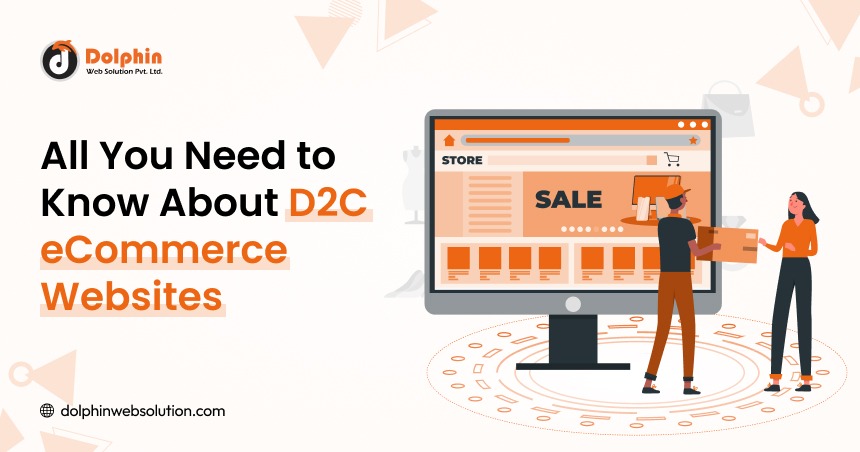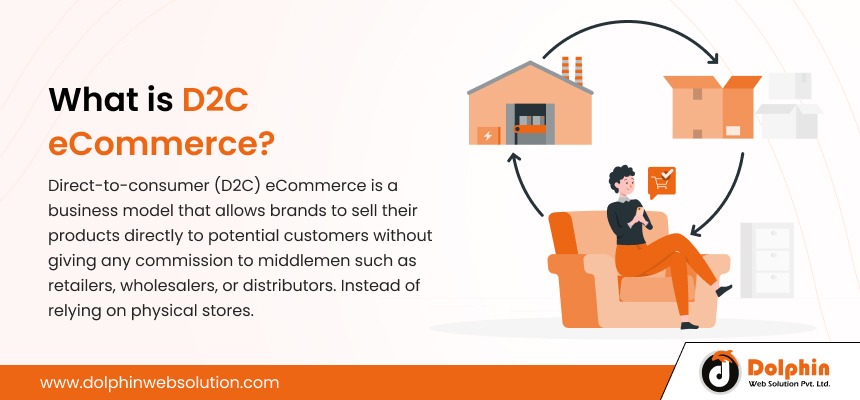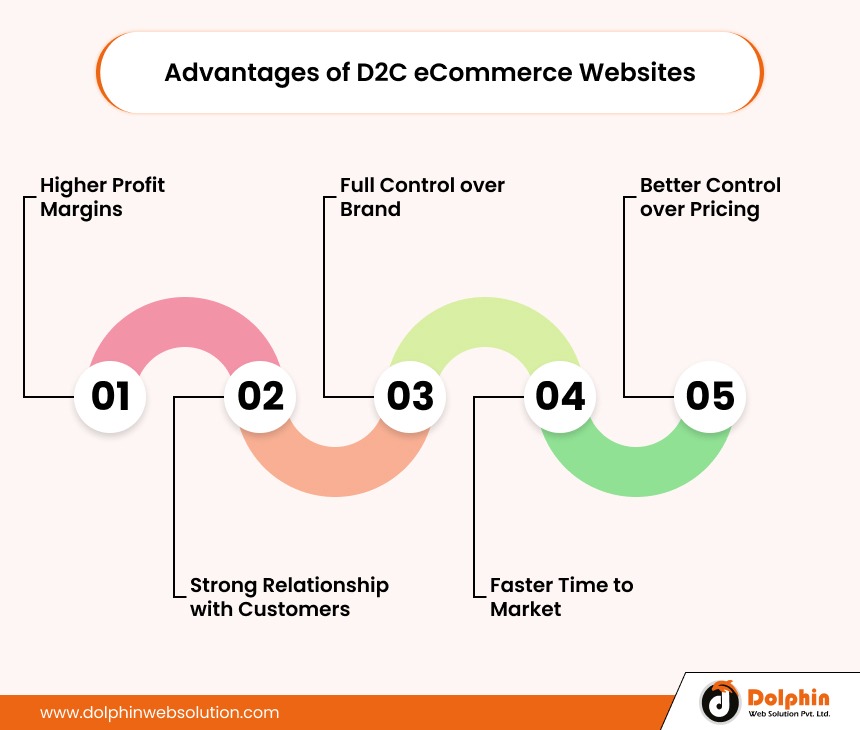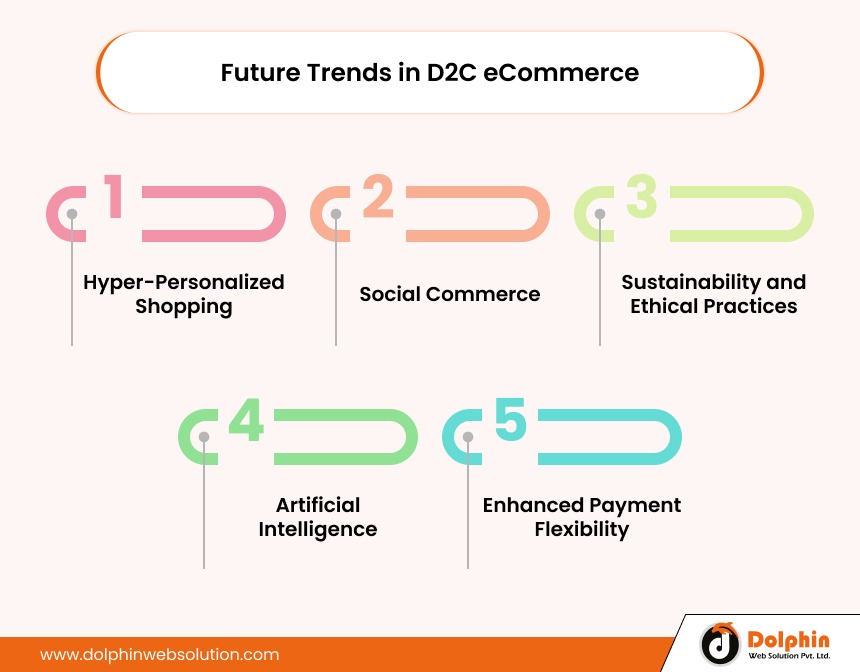All You Need to Know About D2C eCommerce Websites

Table of Contents
Summary :
The D2C eCommerce model is rapidly expanding, and now, brands prefer this model to gain complete control over their business, increase profit margins, and build a strong presence. However, there are various challenges that brands need to handle. Here, we will understand D2C eCommerce, its benefits and challenges to resolve to succeed.
Did you know? The global D2C market will reach $187 billion by 2025. It shows how fast the Direct-to-Consumer (D2C) eCommerce industry has shifted, and brands now choose to sell directly to customers without retailers.
Traditionally, eCommerce brands follow a retailer business model where the product goes from manufacturer to wholesaler to distributor to retailer to customer. That’s a really long and too dependent model, but D2C websites cut out the middleman and direct brands to sell products to customers to make the process faster and more efficient.
In this way, brands can connect with their potential customers more personally and provide a better shopping experience.
Almost every giant brand, such as Walmart and Amazon, is now dominating the eCommerce market with a D2C website approach. It’s become popular in recent years.
However, many businesses are still unaware of the D2C website approach and how it is more beneficial for their business growth. Don’t worry!
In this article, we will understand everything about D2C eCommerce, its benefits, features for a successful D2C business website, future trends and estimated D2C eCommerce website development cost.
So, without any further delay, let’s dive in!
What is D2C eCommerce?

Direct-to-consumer (D2C) eCommerce is a business model that allows brands to sell their products directly to potential customers without giving any commission to middlemen such as retailers, wholesalers, or distributors. Instead of relying on physical stores. D2C brands like Sports eCommerce website can directly reach potential customers and sell products.
When brands switch to the D2C model then, they find this model more appropriate because now they can connect with their potential customers at a personal level and provide them with a more efficient experience and effective pricing after removing middlemen such as a vendor, a reseller, or a retailer, which helps them increase profit margins and build strong relationships with their customers.
Advantages of D2C eCommerce Websites

Here are some critical advantages of D2C eCommerce website:
1. Higher Profit Margins
The profit margin increases when a brand sells its products via the website directly to customers and removes all the middlemen, such as retailers, wholesalers, or distributors. So that brands can earn more on each sale and grow rapidly.
2. Strong Relationship with Customers
Having a D2C website is the most interactive and personalized way for brands to connect with their potential customers, provide a seamless shopping experience and build a strong relationship between the brand and customers.
3. Full Control over Brand
A D2C website gives brands complete control over their brand operations, such as selling methods, customer shopping experience, packaging, inventory and shipping management. Such control over brand operations allows them to ensure everything is working fine and aligns with brand identity.
4. Faster Time to Market
When a brand cuts out all the middlemen, such as retailers, wholesalers, or distributors, it becomes much easier for brands to launch the product quickly without waiting for retailers’ approvals or alignment with their schedules.
5. Better Control over Pricing
D2C brands have the complete authority to set their prices because now they’re selling directly to customers without worrying about the margin for retailers. Such control over pricing allows brands to make efficient decisions like offering discounts, running marketing campaigns, or adjusting prices as per market demand and competition.
Key Features of a Successful D2C Website

Here are some key features that take to build ecommerce website in D2C:
1. Automated Inventory and Order Management
One of the essential ecommerce website features that every D2C website must have is automated inventory and order management. This feature helps brands keep track of their stock levels and orders automatically to optimize the inventory.
2. Personalization
Personalization is the biggest weapon for D2C brands to increase their sales and build loyal customers. As per the studies, 7 out of 10 retailers see results of at least 4X and fewer abandoned carts after implementing personalized shopping experience.
3. Excellent Live and Chatbot Support
Live chat and chatbots are the most effective ways to provide support to potential customers 24/7 with quick responses without any human interaction. It helps brands save time and let the chatbots engage with customers, resolve their queries and recommend relevant products to boost sales.
4. Omnichannel eCommerce
It’s very easy to understand that brands using multiple channels to sell their products are more likely to generate more revenue and high customer engagement. This is where an omnichannel feature is essential for every D2C website to let the brand sell its products on multiple channels, including website and social media channels.
5. Logistics Management and Order Fulfillment
Selecting the right shipping partner is a crucial thing for your D2C business success. It handles shipping, delivery, and tracking to ensure the order arrives on time. A good partner must have various fulfillment centers to ensure the fastest delivery and flexibility during returns.
6. Marketing Automation
Marketing Automation is essential when running a D2C brand because you need to constantly engage with potential customers, send emails, handle social media posts and recommend relevant products, which help drive more sales and build loyalty with customers.
Challenges in D2C eCommerce

Implementing a D2C approach for brands surely has numerous benefits, but some challenges must also be faced. Here are some significant challenges of D2C eCommerce:
1. Competing with Retailers
When a brand starts selling directly to customers via the D2C website, one of the biggest challenges it must face is high competition with its retail and distribution partners. Many retailers may not welcome the idea of a brand also having its online store, which is why many brands prefer balancing their approach by offering products over websites and distributing them to retailers to avoid overlap.
2. Order Fulfillment
Switching to a D2C model can be challenging for those brands that rely on traditional retail, especially when it comes to fulfilling orders quickly because customers expect fast delivery of their orders and real-time tracking status.
3. Building Trust & Customer Service
When a brand prefers the D2C model, building trust can be challenging. Previous customers bought from retailers, but now brands need to build a strong reputation of their brand in the market that builds trust in customers to buy products directly from the brand.
4. Cost of Marketing and Branding
When a brand switches to the D2C model, profit margins will undoubtedly be higher because all the middlemen were removed, and now brands are directly selling to customers. However, another challenge they face is the cost of marketing and branding. Now, they need to spend their budget on marketing and branding to sell their products directly to customers, which requires a good investment overall.
5. Customer Acquisition
Previously, brands only relied on stores to bring customers. However, when they switch to the D2C method, the challenge is different: attracting potential customers to their website, building trust, and selling. However, new customer acquisition can be difficult and costly.
Cost to Develop a D2C Website
When building a direct-to-consumer (D2C) e-commerce website, an eCommerce website cost can range between $2,000 to over $200,000 for small- to large-size D2C websites. However, several factors can affect the cost of D2C website development, including website complexity, features, customization, maintenance, time duration and more.
Future Trends in D2C eCommerce

These are the top five future trends in D2C eCommerce:
1. Hyper-Personalized Shopping
One of the latest trends in D2C eCommerce is hyper-personalized shopping, where D2C brands mainly focus on providing their customers with a more personalized shopping experience; this includes relevant product recommendations, a fast searching experience, custom offers and a quick checkout process, which makes the overall shopping experience better.
2. Social Commerce
Did you know? More than 5.17 billion people are on social media platforms like Facebook, Instagram and Pinterest, spending most of their time for D2C brands; social commerce is a vital part of directly interacting with customers via social channels to build trust for the brand and drive sales much faster.
3. Sustainability and Ethical Practices
Customers nowadays expect D2C brands to prioritize sustainability and prefer eco-friendly packaging during delivery. So, it becomes essential for D2C brands to meet these expectations and prefer sustainability to build trust for the brand.
4. Artificial Intelligence
AI is now playing a crucial role in the eCommerce industry, especially for D2C brands. It helps brands analyze their potential customers’ data, understand their interests, and recommend the most relevant products that drive more sales.
5. Enhanced Payment Flexibility
One of the biggest reasons for cart abandonment in eCommerce is limited payment options. As per the recent survey, 73.14% of cart abandonment happens, and D2C brands need to resolve the cart abandonment issue by adding multiple payment options and letting customers pay as per the covenant way.
Conclusion
The Direct-to-Consumer (D2C) eCommerce model is now a fast-adoption model, and brands prefer to sell directly to customers to increase their profit margins, gain complete control over their business, and build a brand in the market. However, it’s essential to understand the D2C eCommerce model before switching to it. Because as many rewards are getting, there are various challenges that D2C brands need to face and resolve. We hope this article helps you understand everything about D2C eCommerce, the benefits of a D2C website, and the features and challenges that need to be resolved. Now, it’s your turn to hire an experienced eCommerce website development company and let the professionals build your D2C website as per your business needs.

Hello!
Click one of our contacts below to chat on WhatsApp

